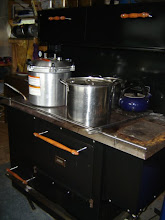
The Fiddleheads are bursting out of the ground this week. These are my "wild asparagus". When picked young, they are a delicious spring vegetable. Of course, when picking anything wild, be sure to positively identify the plant first. Fiddleheads are a distinct wild food, and once you know where to find them, they are as reliable as spring rains.
Collect the fiddleheads as soon as they emerge from the ground, and snap them off. Like asparagus, the stem will snap at the point where it is still crisp and fiberless. The trick to removing the fuzz is to rub it off dry. Once they are wet, the fuzz does not come off easily. To prepare them, I prefer steaming rather than boiling. Bring the water to boil first, then place the steaming basket and vegetables over the water and cover. Fiddleheads will discolor if placed over low heat while the water comes to a boil. Steam them until crisp-tender.
They can be enjoyed with any number of sauces. Simply butter, garlic and salt. Hollandaise or cream sauce. Even as a cold vegetable in salads with vinaigrette dressing.
This is our favorite time of year to take long evening walks with the dogs. We wander through old logging roads to get front row seats at the nightly chorus of Spring Peepers, Robins, Sparrows, and Thrushes, their flutes and whistles syncopated by the drumbeat of breeding Ruffed Grouse and the windy whooshy wing beat of breeding Common Snipes. We even caught sight of two bear cubs dutifully waiting in a couple of birch trees about 1/4 mile off. Mama Black Bear eventually returned to her cubs, and we moved off to leave them undisturbed.
But not before I took a few video clips of the Peeper chorus. I was determined to catch sight of one of them, they were so close, but they were too well disguised. But you can see the rippling in the water, this pond was teeming with them.
Back on the farm, we have planted out most of the feed grains. One half acre of wheat, and one half acre of oats. We will also be planting about 1000 row feet of peas, as well as millet and amaranth for feed crops.

And I brought a bit of the wild into my herb garden this spring. We have a few patches of wild caraway around the pastures, and last fall, (after studying the plants at various stages of growth for over a year to be sure it was caraway and not poison hemlock), I collected what I could of the seed heads, giving me a few ounces to use in the kitchen, and some seed to start in the spring. But when I saw these second year roots popping up along the pasture this spring, I decided to try transplanting some of the roots into a prepared garden bed. Wild caraway is a biennial, so it only produces seed in it's second year. There is a cultivated annual variety, but like fennel and anise, it is a long-season crop, and frost usually threatens my nearly ripened seed heads. But these second year roots, which took quite well to the uprooting and transplanting, will produce early and hopefully prolific seed heads.









No comments:
Post a Comment